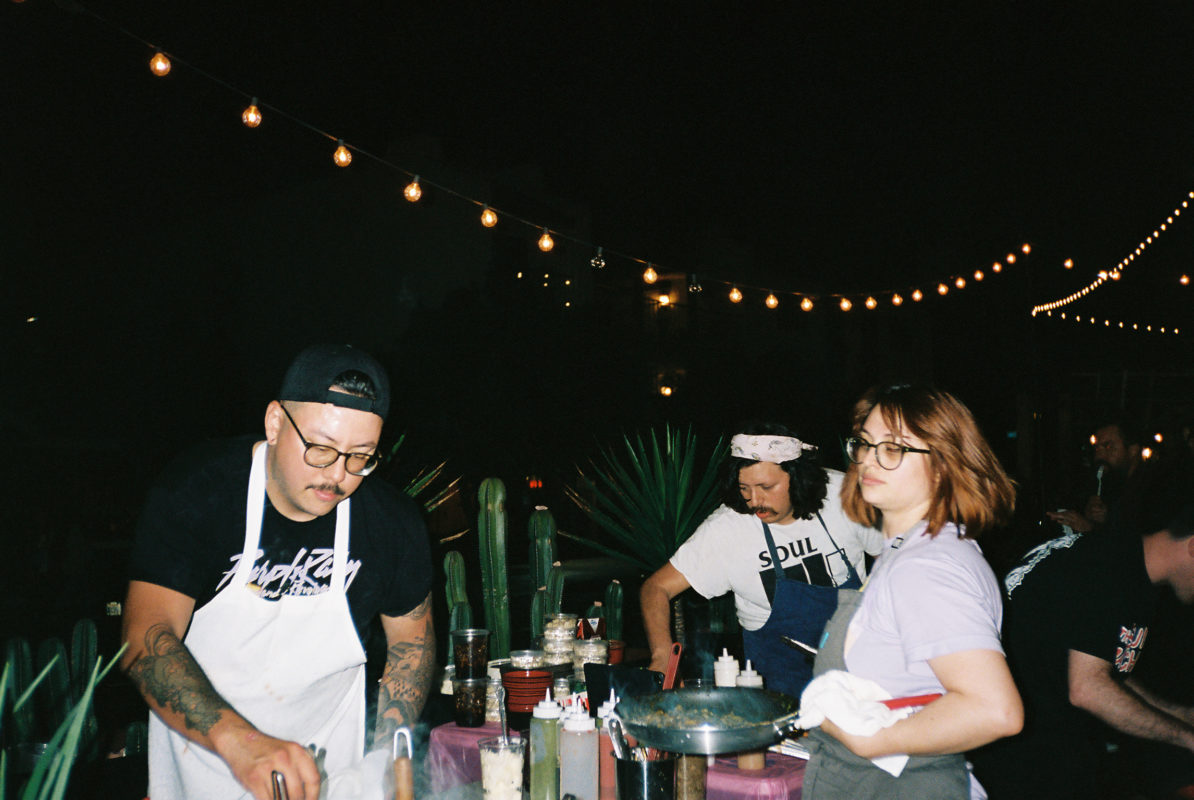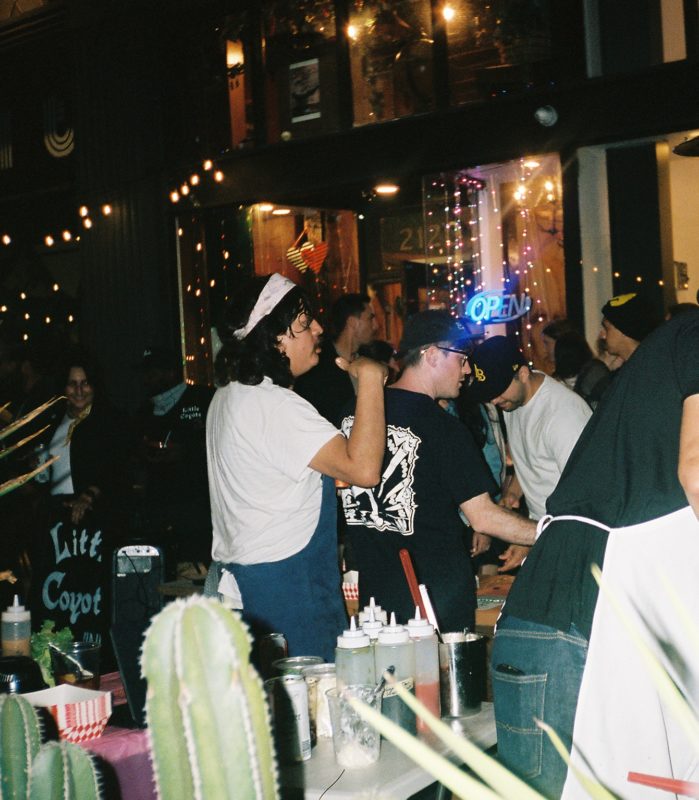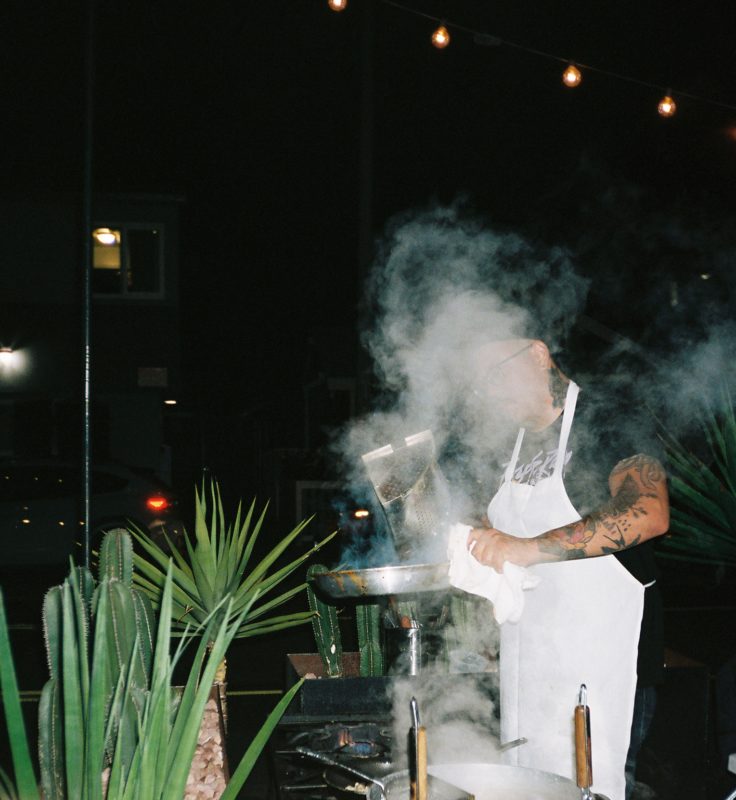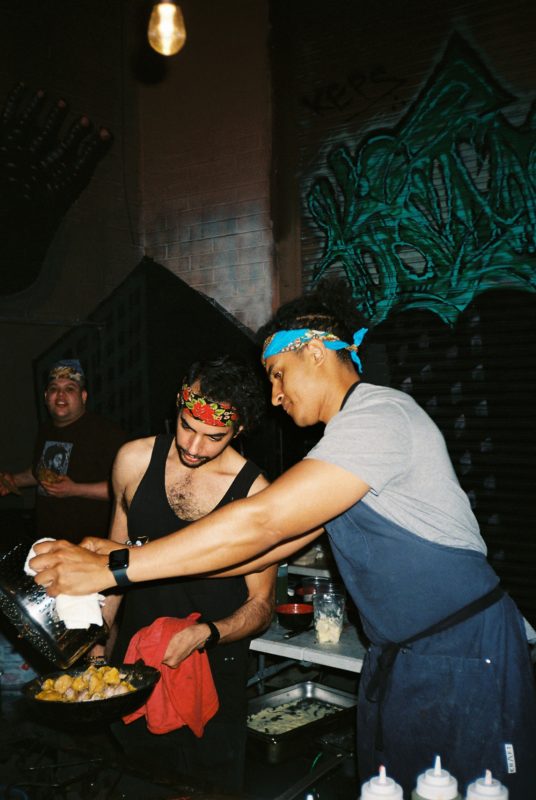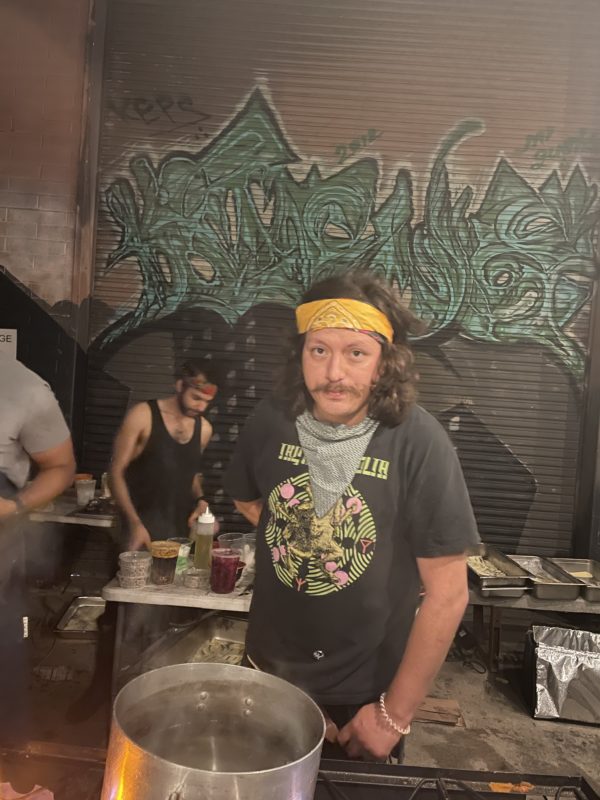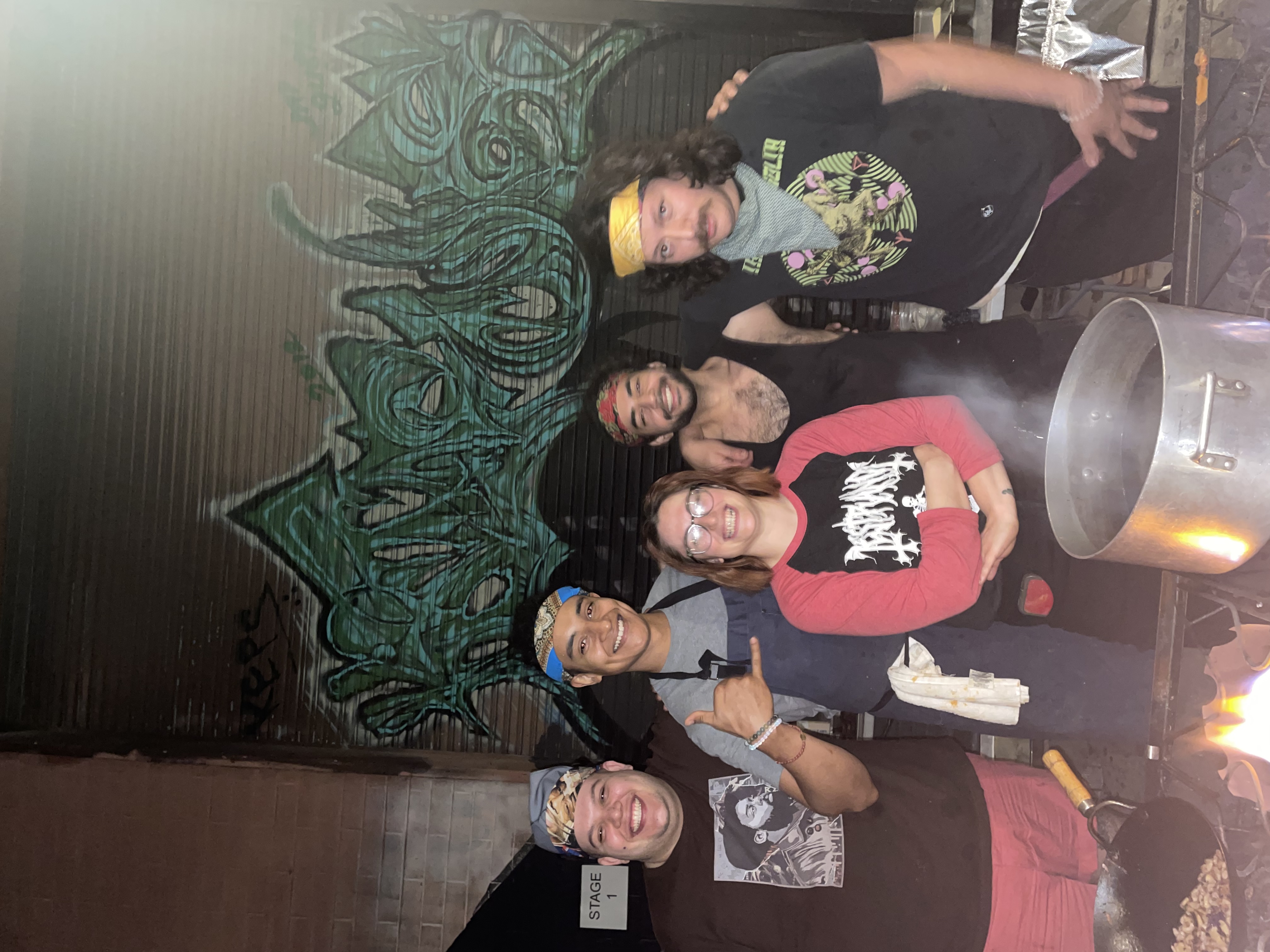Chef Diego Argoti brings fine dining knowledge to sidewalks and alleys
Though he never attempted to cook to a specific crowd, punks were the people that he could relate to most. And they were the crowd that Chef Diego Argoti naturally attracted — the logo for his concept kitchen, Estrano, is an avocado with a ball gag. Yep, where the seed goes. It would be hard to imagine another group of people willing to eat food in an alley, but don’t let the setting fool you. Imagine a classically trained artist switching to graffiti midway through their career. Apply it to food and you get Estrano. “We know what we are doing is for a very special crowd, but it’s a very dedicated crowd,” said Diego.
. . .
As I approached the general location Estrano had given, it appeared as if I had gotten lost. It was in the industrial part of Chinatown, by the LA river, surrounded by tall rusted out warehouses. Not necessarily abandoned, but a Scooby-Doo villain would have no problem setting up HQ here. The only thing that kept me from turning back was my pursuit of Nashville chicken frog legs and the long drive back to my apartment in Long Beach with my head down, like Charlie Brown. Yet, as I turn the corner there’s a line of about 175 people waiting for the same thing. Unsurprisingly, they sold out of the frog legs before I got the chance to order it.
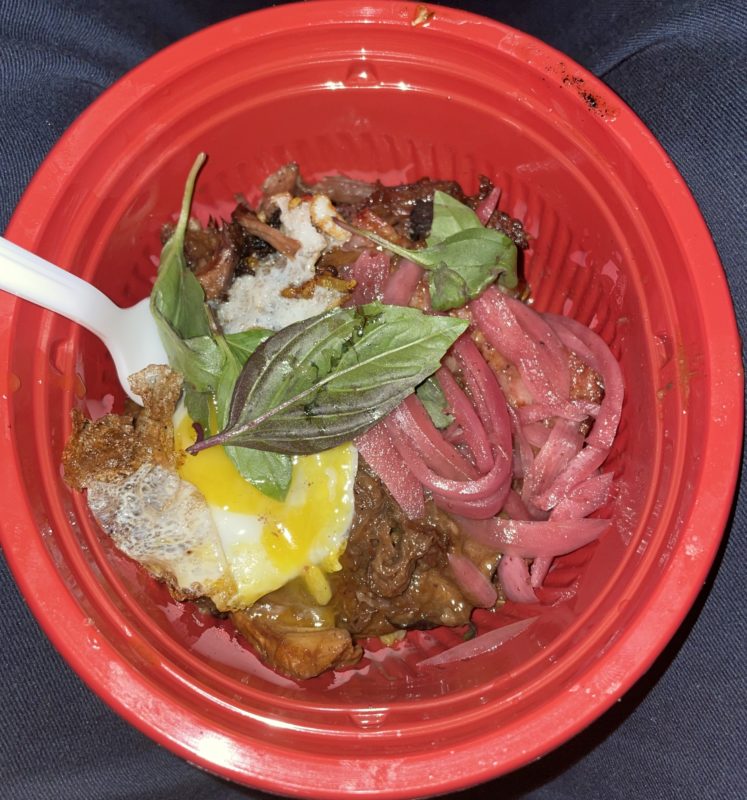
Thankfully they had Beef Tongue Loco Moco, fusion between Latino and Hawaiian, and my current personal favorite. Lengua, a meat selection that usually appears in tacos as a chewy but flavorful cut, in this dish felt tender like a good cut of steak. I almost thought I grabbed the wrong bowl, because the texture shattered my expectations of what lengua is supposed to be.
. . .
Diego had previously worked at Bestia as a sous chef, one of the most renowned Italian restaurants in California. Here, he took the long route to become the sous chef. Diego’s restaurant experience is longer than a rap sheet (a few years at Bavel, a couple at Broken Spanish). He was the guy for research and development of menus, writing cook books for restaurants, taking all the training programs available (2 years on a bread program and 3 years as the butcher, “trying to understand food.”)
It really reflects in his work. Diego experimented with characters and flavors stemming from unpredicatable origins for his most recent menu. Like “how flavors got to different countries, like the silk road or the occupation of France,” said the chef of Estrano. He describes his process of creating Pig Ear Spaetzle which was inspired by funnel cake or a “German carnival dish.” After adding ingredients to try and balance the flavors, the flavors, Diego said, the end result was more of a Chinese dish. It consisted of purple cabbage, black garlic and date gastrique, and tarragon salsa verde.
Four propane burners, and a few folding tables
Since they cook outside with propane burners and whatever kitchen supplies they need, each concept is a separate experience. There’s no recurring theme. There’s no branded food truck. The menu changes frequently. It’s not like Diego can’t afford a food truck. In fact, investors hit him up to start restaurants, “but that’s not Estrano.” And it makes sense. Having them cook in a kitchen would take away the adrenaline from the cooks and their customers, even if it’s just the walls of a food truck.
Their alleyway pop-up on March 21st was one of their busiest yet. Estrano’s die-hards and their new fans recognize eating in an alley is one of the core elements of their concept. It’s like seeing a punk band under a freeway underpass. It’s sort of a right-of-passage, separating the casuals and the fanatics.
Estrano has a transformative effect, “When we left, it was still an alleyway. The food, and the burners, and the tables and whatever made it an experience to eat food is gone,” said Diego. “We took something that people walk by every day, or avoid, and we turn it into something that was very special.”
There is very much a performance element to what they do. People circle around the set up like it’s a stage, the audience watching quietly, occasional murmurs. If people were having full
conversations, it was 20 feet away, as if they don’t want to interrupt the experience. Diego said it’s something that created itself. “Everything was going out [of other kitchens] in boxes, during the pandemic. We definitely wanted to be very transparent about our set up, how we’re cooking, what we’re cooking, the elements we’re cooking in.”
“Letting Estrano be something for someone else.” – Diego
When working as a sous chef at Bestia, Diego said his goals were completely different. “The point of cooking was to have the best food and the busiest restaurant.” At this point in his career, Diego is focused on philosophical goals. “Right now, it’s about being happy and building a team. It’s about letting Estrano be something for someone else.”
Whether it’s his cooks or his customers, they all recognize that.
Marco Angeles, his day one, has been a friend since high school. While Diego worked on the first menu, Marco would be outside working on his motorcycle, then help Diego roll out pasta. Marco was there for the first pop-up as a cook. “It was a shit show,” he laughs. “We forgot everything…arriving late. But, you know what: if the food is good the people will come.” He was at the Little Coyote (Long Beach Pizzeria) collaboration two years later. This guy was here at 10 pm standing over a hot burner and had to leave for Arizona early the next morning, before the worms or birds wake up. Why? Because, “Diego’s the homie and I got to help out the homie.” It’s not like Diego is short staffed either, he could choose from 12-14 cooks. Marco wanted to be here.
Before Estrano, it was a separate story. Diego had “no problem making [employees] feel like they don’t belong.”
On top of that, he had a “massive drug addiction that felt like it didn’t have an end.” It was in the height of all this, mid-pandemic, where he had to quit Bestia to take care of his father. It took a couple months for the concept to develop. “Estrano gave me the chance to not be that chef anymore.” Not only that, but he sobered up. “It gave me something more to obsess over.” Diego added.
Diego didn’t have to build his team of cooks, they gravitated toward him. “It was never a matter of convincing anyone,” said Diego. At the beginning, former coworkers came to eat, even to help. They stepped in the kitchen for him when he needed it. The same ones that Diego mistreated back in other kitchens.“It’s really a big support team, it almost reminds me of a chef halfway house,” said Diego. At first, he felt embarrassed seeing them, remembering how he had spoken to them. One of his former coworkers at Bavel, now a cook at Estrano put it nicely: “At first Diego and I didn’t know that we were going to be friends, and now we’re the best of friends.”
I may be staring at the sky too long, finding Orion’s Belt, but connecting three random stars. There is a common theme: the ingredients, the alleyways, and his personal life. Estrano transforms it. How Diego managed to do this, I’m not sure. It could be the love, the authenticity, or pure luck. But Estrano is what makes the beef ravioli with ketchup and mustard sauce taste like fine dining. Estrano is what brings people from all over LA to walk down an alley at 9 pm to hang out and eat. When I asked Rachel Verharst, one of the cooks, what Estrano meant to her, she said, “It’s the craziness, the fun, the passion for food, and doing whatever the fuck we want.”


